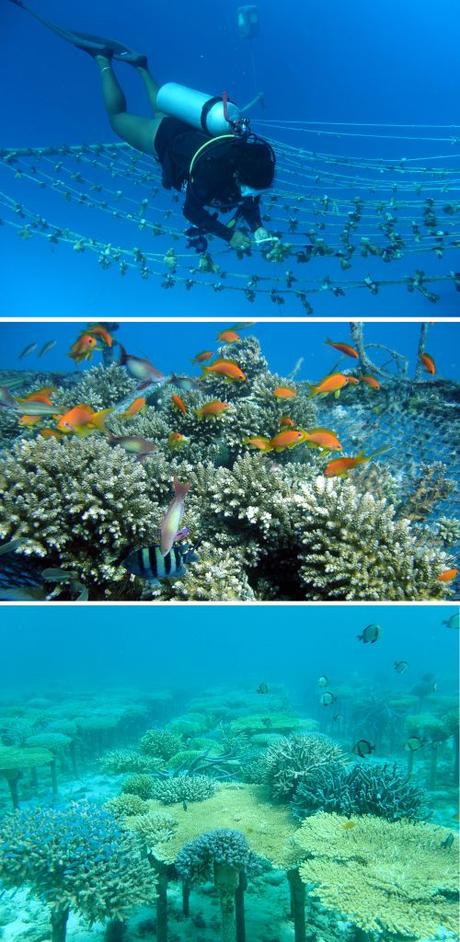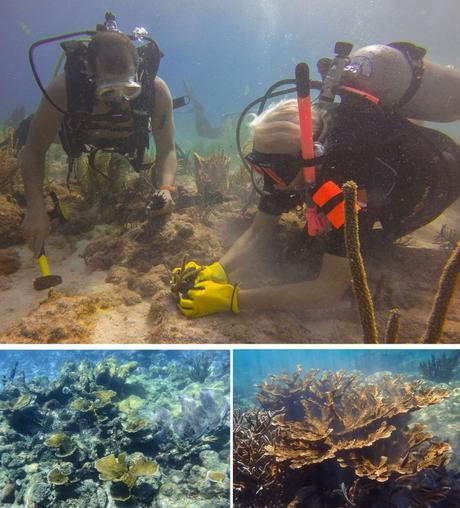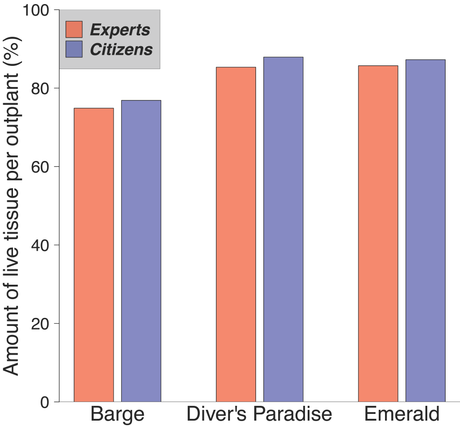It is possible to cultivate corals in the sea like growing a nursery of trees to restore a burned forest. Cultivated corals grow faster than wild corals and can be outplanted to increase the healthy area of damaged reefs. Incorporated in projects of citizen science and ecotourism, this activity promotes environmental awareness about coral reefs, the marine ecosystem that is both the most biodiverse and the most threatened by global change.
When I finished by undergraduate studies in the 1980s, I met several top Spanish marine biologists to prospect my first job ever in academia. In all one-to-one interviews I had, I was asked what my interests were. And when I described that I wanted to study ways of modifying impacted marine ecosystems to restore their biodiversity, a well-known professor judged that my proposition was an inviable form of jardinería marina (marine gardening) ― those words made me feel embarrassed and have remained vivid in my professional imagination since. Neither the expert nor the young researcher knew at the time that we were actually talking about ecological restoration, a discipline that was being formalised exactly then by botanists in their pledge to recover pre-European conditions for North American grasslands (1).

Today, the term coral gardening encompasses the suite of methods to cultivate corals (tiny colonial jellyfish with an external skeleton and a carnivorous diet) and to outplant them into the wild to boost the growth of coral reefs following perturbations (2). In the face of the decline of coral reefs globally, due to the combination of climate change, pollution, and overfishing (3), this type of mariculture has gathered momentum in the last three decades and is currently being applied to more than 100 coral species in all the main reefs of our seas and oceans (4-6).
Bringing corals to people
Partly inspired by principles of forest restoration (7, 8), the rehabilitation of a reef through coral gardening can be envisaged very much like a campaign of reforestation of a patch of land with local tree species. An outstanding example was the citizen-science program Rescue a Reef (see videos here) done between 2015 and 2017 by Dalton Hesley and collaborators off Miami (Florida, USA) (9). That program trained 230 volunteers to deploy more than 1300 staghorn corals. Placed in a straight line, the whole set of coral nubbins would add up to half a kilometer.
In parallel, the authors did an experiment whereby a group of volunteers was compared to a group of experts in outplanting sets of 50 corals in each of three different reefs. The good news is that one month following the experiment, the 300 corals outplanted by the two groups were alive. In addition, the amount of live tissue per coral was consistently > 75% indistinguishable in coral transplantations done by both experts or volunteers. Everybody had done an excellent job.

The costs of coral-reef restoration greatly exceed the costs of restoration of other types of marine ecosystems like mangroves, saltmarshes, and seagrass beds (10). Coral-restoration actions require an (average) investment of > US$400,000/hectare, which varies across projects and countries (11). For that reason, Hesley presents citizen science as an attractive option for increasing the volume of coral outplants globally at lower costs, with the added educational value that involving people like you and me entails (9).
And such type of coral-gardening initiatives seem ideal products for the ecotourism industry in island and coastal areas (5) ― why would tourists, with an environmentally friendly and/or sea-loving mind, not embark on free dives and plain-language ecological knowledge in spectacular seascapes during a summer holiday?
Protection is better than restoration
The technology of coral-reef restoration has evolved rapidly. At present, coral gardening can be done by means of suspended ropes, on blocks of concrete placed on the seabed, on horizontal nets (suspended in the water column or anchored to rocky bottoms), and at land-based coral nurseries maintained from donor coral colonies (12). The little coral fragments under cultivation grow 20 to 50 times faster than wild corals (13), and such a pace can be multiplied if outplantings are placed a few centimetres between each other, so that they end up fusing together as they grow (14).

Coral gardening offers prompt and eye-catching results, a rare outcome in projects of ecosystem restoration. And ongoing research aims to select coral outplantings that are resistant to stress such as warming and whitening (15, 16). However, a debate exists about the cost-benefit trade-off of active (gardening following impacts) versus passive (protected areas avoiding impacts) interventions to safeguard large areas of reef (17, 18). As many other worthy things that we humans do, the debate becomes a bit ridiculous if put into perspective, as the restoration of a hectare of coral reef costs 25 times less than a war tank, or 75,000 times less than US gift expenditures for Saint Valentine’s Day (Sarah Frias-Torres, pers. comm., 28/07/2021).
To date, protecting is still cheaper than restoring nature. This difference is even greater if we take into account that restoring a megadiverse ecosystem (like a tropical rainforest or a coral reef), in terms of recovering all their native species and the interactions among them and the ecological roles they play, will often take decades, if not centuries or millennia. Along those lines, the Society for Ecological Restoration recommends active interventions (like coral gardening) only when an ecosystem has lost its natural capacity of regenerating itself (19). At any rate, for the specific case of coral reefs, we need a global strategy of conservation of the fifty > 50,000-ha areas of coral reefs most vulnerable to global (particularly climate) changes (20), in combination with restoration programs where and when they can be most useful.
Acknowledgements Thanks to Sarah Frías Torres for revising an earlier draft of the Spanish version of this blog, published by the journal Quercus in October 2021
Literature
- Jordan WR, Peters, RL & Allen, EB (1988). Ecological restoration as a strategy for conserving biological diversity. Environmental Management 12: 55-72
- Rinkevich B (1995). Restoration strategies for coral reefs damaged by recreational activities: the use of sexual and asexual recruits. Restoration Ecology 3: 241-251
- Hughes TP et al. (2017). Coral reefs in the Anthropocene. Nature 546: 82-90
- Rinkevich B (2019). The active reef restoration toolbox is a vehicle for coral resilience and adaptation in a changing world. Journal of Marine Science and Engineering 7: 201
- Schmidt-Roach S et al (2020). Beyond reef restoration: next-generation techniques for coral gardening, landscaping, and outreach. Frontiers in Marine Science 7: 672
- Rinkevich B (2021). Augmenting coral adaptation to climate change via coral gardening (the nursery phase). Journal of Environmental Management 291: 112727
- Horoszowski-Fridman YB & Rinkevich, B, in Marine animal forests: the ecology of benthic biodiversity hotspots, S Rossi, L Bramanti, A Gori & C Orejas, Eds. (Springer, 2017), pp. 1-23. doi:10.1007/978-3-319-17001-5_36-1
- Epstein N, Bak, RPM & Rinkevich, B (2003). Applying forest restoration principles to coral reef rehabilitation. Aquatic Conservation: Marine and Freshwater Ecosystems 13: 387-395
- Hesley D et al (2017). Citizen science benefits coral reef restoration activities. Journal for Nature Conservation 40: 94-99
- Bayraktarov E et al. (2016). The cost and feasibility of marine coastal restoration. Ecological Applications 26: 1055-1074
- Bayraktarov E et al. (2019). Motivations, success, and cost of coral reef restoration. Restoration Ecology 27: 981-991
- Omori M (2019). Coral restoration research and technical developments: what we have learned so far. Marine Biology Research 15: 377-409
- Vaughan D et al. (2019). Building more resilient coral reefs through new marine technologies, science, and models. Marine Technology Society Journal 53: 21-24
- Forsman ZH et al. (2015). Growing coral larger and faster: micro-colony-fusion as a strategy for accelerating coral cover. PeerJ 3: e1313
- van Oppen MJH et al. (2015). Building coral reef resilience through assisted evolution. Proceedings of the National Academy of Sciences of the USA 112: 2307-2313
- Morikawa MK & Palumbi, SR (2019). Using naturally occurring climate resilient corals to construct bleaching-resistant nurseries. Proceedings of the National Academy of Sciences of the USA 116: 10586-10591
- Haisfield KM et al. (2010). An ounce of prevention: cost-effectiveness of coral reef rehabilitation relative to enforcement. Conservation Letters 3: 243-250
- Bayraktarov E et al. (2017). Response to “Rebutting the inclined analyses on the cost-effectiveness and feasibility of coral reef restoration”. Ecological Applications 27: 1974-1980
- Gann GD et al. (2019). International principles and standards for the practice of ecological restoration. Second edition. Restoration Ecology 27: S1-S46
- Hoegh-Guldberg O et al. (2018). Securing a long-term future for coral reefs. Trends in Ecology and Evolution 33: 936-944
- Frias-Torres S & van de Geer, C (2015). Testing animal-assisted cleaning prior to transplantation in coral reef restoration. PeerJ 3: e1287
- Unsworth JD et al. (2021). Outplanting optimized: developing a more efficient coral attachment technique using Portland cement. Restoration Ecology 29: e13299

